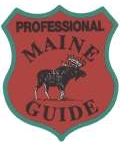“Imagine after being exhausted at the end of a hard day, you are coming home to this [long silence]. In the little remaining daylight he cannot possibly return to his main hut, his only recourse is to fix this one.” – Werner Herzog from Happy People
The trapper then commences to put his small cabin back in shape by removing the log (with what I’d call a large hatchet), sloughing off the 5′ of snow on the roof, and then, while softly humming to himself, lighting a fire in the wood stove. While it isn’t clear how cold it is throughout this unexpected home improvement part of the documentary, seeing how he is rocking a few solid beardsicles, it must be at least in the teens, as I have found from experience that you don’t get good facial ice until it is at least that cold.

Man and dog sharing an “OH Sh**” moment
Why do I love this scene? Two reasons. I empathize completely with his reaction (seen in the picture with the dog). This is a moment that we can all identify with. I have seen (and made) that stationary stare, it’s not really looking at the problem as much as it is a glazed over reflection on life, like “Really? Is this what’s going on?” Or perhaps it is an “oh sh** moment.” Either way we all have been in that place, it’s a moment of universal suffering/ resignation that we truly are not in the driver seat. Plus, I love that his dog appears to be having the same thought.
The second reason I bring this scene to you is more personal. While I don’t live in that remote corner of the taiga, I do live in a tent in the woods, off the grid, and have to deal with, admittedly to a lesser degree, many of the struggles the trappers and townsfolk deal with in the documentary. These are common problems anyone has to deal with if you live more or less outdoors; outdoors as in a house/cabin/tent that won’t function without you and that only keeps nature at bay, not completely out. That means your house freezes in the winter, is full of bugs in the summer and provides only a thin veil of protection from the elements. You put in the work to keep it warm, to bring in water, to keep animals out, and to make it comfortable. And the real test is this: imagine coming home to your house and finding the scene above, what would it take to get through the night? Your heat would still probably work, water would still come out of the tap, and you’d have a phone to order a pizza. The point is that living in a modern house and living like the Bob Villa of the Bush in the movie are different lives, very different.

Future syrup
Spring has come early to us in Northern Wisconsin. It is April 4th and we have already had 2 weeks of spring; the ice is off the lake, the snow is mostly gone and the daffodils are poking up around town. The warm days and cool nights have prompted the maple trees on my property to start running sap, and so begins the sugar making season. The process is simple enough- drive in a metal tap, collect the sap (40:1 water to sugar), then boil down the sap until you are left with a thick, sweet syrup. I do it the old fashioned way, pots suspended over an open fire. I don’t have wood delivered so my days are long, collecting wood and keeping the kettles on a rolling boil. A big wind came through the area two days ago while I was boiling and blew over a 40 foot dead poplar, almost squishing me and my dog and completely destroying my boiling rig. Luckily the kettles didn’t spill and both dog and I came away unscathed. Needless to say next time I see a tree and think “You know, I should take that down before it falls on us,” I’m gonna do it. After putting my syruping rig back together I headed back to my tent where I had found the wind had blown down half of my tarp, one end of my tripod holding up the tarp and also disassembled my stove pipe. This was at 7 pm. I was exhausted. So I went back to work fixing my house until well after dark. That’s life in the bush; there is no guarantee that you’re day will ever be over.
It occurs to me as I sit here in my 9′ x 12′ canvas wall tent just above the 45th parallel north, that there is a growing distinction between those people who view bushcraft as a hobby, like model ship building or betting on the ponies, and those who treat it as a lifestyle. I remember a day last fall during the Wilderness Bushcraft Semester when a student said to me “You seem to be into fly fishing way more than bushcraft.” This gave me pause, because on the surface he was right, but when I thought about it more I found the truth: I am obsessed with fly fishing, but it is a hobby, something I do for my overall well being, but it is not integral to my life. It would be similar to saying to someone with a regular 9-5 job and a modern home “Gee, you seem to be more into golf than paying your heating bill or grocery shopping.” And they’d be right, but what we do to pay to the bills, so to speak, is (or should be) a greater measure of what we value; garnish makes a great steak even better, but the steak is the reason we’re there.
I have seen it often amongst people who, for many reasons- time, interest, ability, treat bushcraft as a hobby. There is endless talk around the campfire and comparison of knives, canoes, axes, or whatever. While there is always an inevitable level of this style of conversation amongst passionate outdoors folk as this is how we learn more about our craft or how to improve technique, there a big difference between having these discussions out of function instead of out of form. For example, I appreciate a good axe and I am happy to debate certain qualities of head weight, manufacturer, handle material and grain pattern or bit profile, but ultimately I don’t really care, not because it isn’t important, but because I probably use an axe 300 days a year and it has become less important to me what axe I have as long as its sharp. It is like the 3 part act all of us go through when we learn a skill:
- The novice knows nothing and has nothing but is open to everything
- The skilled acquires everything and gains ability
- The master has nothing but can do anything
I am a novice guitar player. I have put in my share of hours learning how to pick, and I was in a band for a score of years, but I am far from an expert; far from living the life of a musician. I can talk the talk at a guitar shop and bust out chop or two but when it comes down to having an opinion on the fine points of being a luthier, professional guitar player, or composer I am over my head. I could jump on a forum on the web and pipe my 2 cents into a thread about the value of low vs high string action on an acoustic guitar, medium vs thick picks or who was the greatest guitar player of our time but what is my opinion worth? That’s up for debate, while I think each one of us has a voice worth hearing, at the same time I don’t pretend that my opinion is more than that, the thoughts of an amateur.
So, back to the tent. It is still cold as sin in here, the sourdough starter has froze, wires to solar panels have cracked, and the epoxy for at my fly bench is solid, now ruined because of the cold. I choose to live this way, so I am not playing up the whole “oh woe is me” routine. Far from it, I am happy to live like this because it makes me value what I have. When you go home to an automatically heated home, you rarely think when you walk in the door “Wow, thank goodness that heater works all on its own.” When I come back to an ice cold tent, however, I value every BTU I can get out of my wood stove. That stove is why I started thinking about writing tonight.
A couple of days ago I was scrolling through an online forum debating the functional principles of a wood stove. I think I got hooked into reading a thread on dampers in stove pipes and how they are necessary to run a wood stove because I threw mine out at the beginning of last winter as it caused more problems than it solved. I know from experience that they aren’t necessary, yet here were many people saying they are, who do you believe? As I sifted through the comments I started wondering how many of those posts were written by people whose only source of heat is that stove and it’s intricate engineering they are so hotly debating? I don’t mean to say that their thoughts don’t count, I value any ideas that help improve the tools of our trade, but it did get me wondering what percentage of people online (or off line) who are engaged in the conversations revolving around bushcraft or wilderness living actually live the life?
There is a gulf between living a life directly and vicariously living (romanticizing) a life through other people. To live in the bush is far beyond the imagination of the common public. When I tell people I live in a tent, off the grid, in northern Wisconsin and Maine, year round I usually get a reaction somewhere between pity and appreciation, but both are far from recognition of the reality of the life. Again, this life is intentional, so this is not a sympathy fest, I just want to illuminate the difference between a romanticized lifestyle and the real thing. I don’t of course, live the “real thing” as I said. I don’t hunt and forage for all my food, nor do I make all my clothing. My saw has been replaced by a chainsaw and I have a big ol’ 4×4 to get around. I can’t imagine what it would be like without those things, and it is exactly that thought that keeps me from pretending that I do. The parts of this life I do truly live, I have acquired a great understanding of and appreciation for my knife(s).
Many times have I heard the debate over the best knife to have in the bush. As a matter of fact, there is probably no bushcraft topic that takes more space on the web than what is the ideal knife. Fact is is that the best knife is the one that you have with you when you need it. There are certain qualities that are desirable for sure, but if you look past modern youtube woodsman, to people who lived in the bush for real, you will see a galaxy of ideas of what a knife should look like. Point being is that in the bush you have what you have and while you may spend hours talking about how to make improvements in your tools, at the end of the day that knife you have is going to keep you warm and fed, not just take up space in a drawer. This is the main difference between a craftsman and an outdoorsman – one is involved in the minutia of the product and the other in its use.
There is a similar distinction between outdoor or wilderness schools. There are many where you can take a weekend course on, say survival or flint knapping. There are others set up to run like the National Guard, one weekend a month, one week a year. And for many people those schedules fit into their lifestyles. But we shouldn’t forget that 8 one hour courses is not equal to one 8 hour course. The same goes for longer courses, one year of a few afternoon hours here and there with a weekend a month does not equal 9 weeks of full time learning. The difference is exactly the difference between having an opinion about canvas tent design because you slept in one at a traditional skills gathering and having an opinion because you have lived in one for two years straight. I drive a vehicle but that doesn’t mean I am an expert on automotive mechanics, Newtonian physics or the rules of the Department of Transportation.
The internet has made available to anyone the opportunity to be an expert in just about anything. I can be a degree holding doctor in a few hours, a contributor to a hot rod engine repair forum in a few clicks and a critic of red carpet Hollywood women’s evening wear in a couple of days. All it takes is a few clicks, cribbing other people’s work, doing some cursory research and bam! I am off and posting. This is fine with me, I am sure I do it too (that bit about women’s evening wear may or may not be hypothetical), but it does create a situation where it is can be hard to parcel out truth from opinion. If you are wondering, just ask if they live it. If you live in the bush, there is no faking that you know the intricacies of living in the city and vice versa.









